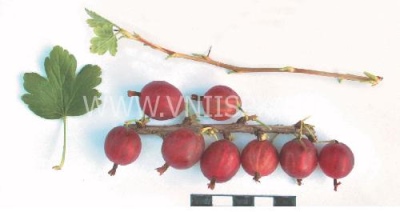
- Authors: M. N. Simonova, I. V. Popova (Moscow Fruit and Berry Experimental Station (VSTISP))
- Appeared when crossing: Date x Lefora Seedling
- Name synonyms: Ribes uva-crispa Rosovy-2
- Year of approval: 1971
- Growth type: medium-sized
- Description of the bush: dense, semi-spreading
- Escapes: non-lignified - green, straight, medium thickness, not pubescent; lignified - thick, light gray in color with characteristic strokes along the entire length of the shoot
- Thorniness: weak
- Thorns: low sheen, dark colored, single, long, thin or medium
- Sheet: large, green, slightly shiny, slightly wrinkled, the blade is located obliquely in relation to the shoot, three-lobed
In Russian gardens, gooseberries are considered an old-timer. Even currants appeared later. Over time, among gardeners spoiled by civilization and an ever-expanding range of fruit and berry crops, the love of gooseberries has gradually diminished. This stems from the taste, which not everyone likes, branches entirely covered with sharp thorns, a problem with harvesting. However, science does not stand still, and breeders are constantly developing new improved varieties and hybrids, reviving the former popularity of the species. The universal variety Pink 2 (synonym for the name - Ribes uva-crispa Rosovy-2) is intended for fresh consumption, conservation and deep-freezing.
Breeding history
The variety appeared thanks to the efforts of the breeders of the Moscow Fruit and Berry Experimental Station VSTISP - MN Simonova, IV Popova. Two varieties took part in the work - Date and Lefora Seedling. The variety was approved for use in 1971.
Description of the variety
A medium-sized shrub with a semi-wild habit has straight, medium-thick low-thorn shoots of green color during growth, thick and light gray after lignification. Shoots are devoid of pubescence; in adult form, they are covered with characteristic strokes along the entire length. A three-lobed large green leaf plate has an oblique arrangement relative to the axis of the branches, with a slightly shiny and slightly wrinkled surface. Single thin, sometimes of medium thickness, thorns are painted in dark tones, perpendicular to the shoots or oriented downward, located along the entire length.
Pros of gooseberry:
- great taste;
- strong immunity;
- high productivity;
- good winter hardiness, self-fertility, transportability.
Of the shortcomings, only the increased exactingness to the landing sites and the presence of thorns can be noted. Pink blooms with 2 large flowers with light green unclosed, slightly bent sepals, whose edges are painted in pale pink shades. Flowers are collected in one-flowered, rarely two-flowered inflorescences.
Characteristics of berries
Rounded-oval large berries (5-6 g), light red at the time of technical ripeness, change color to dark red at the stage of physiological maturity. The dense, non-pubescent skin is covered with a light bloom of prune.
Taste qualities
Juicy sweet and sour pulp has a piquant dessert taste. It contains 13.4% solids, 9.4% sugars, 1.7% titratable acids, 16.0% ascorbic acid and 20 mg / 100 g of P-active substances. The berry has the highest score on the tasting scale - a score of 5.
Ripening and fruiting
The variety belongs to the mid-early category - the crop is harvested in late June - early July.
Yield
Pink 2 has a good yield - on average, up to 5 kilograms are harvested from a bush, and 100-120 centners per hectare.
Growing regions
The gooseberry is adapted for the Central regions and the East Siberian regions.
Landing
The variety is very picky about growing conditions and location, therefore, well-lit areas with reliable protection from winds and drafts are chosen for planting. Fertile loamy or sandy loam soil should have a neutral level of acid-base balance. Landing in wetlands or with a close occurrence of groundwater is not allowed. When digging, they must get rid of weeds, acidic earth is deoxidized with lime or dolomite flour.
A landing pit with dimensions of 50x60x50 cm is prepared in advance. For spring planting in autumn, for autumn planting in spring. The distance between the bushes is 1–1.5 m, in row spacings 2–2.5 meters. The excavated soil is enriched with organic matter (humus, compost, manure), superphosphate, ground limestone, peat, wood ash or potash salt. When planting, the soil is compacted and well watered, the seedling is shortened, leaving 3-5 buds.

Growing and caring
The gooseberry of this variety has a high self-fertility, it bears excellent fruit even without being adjacent to pollinating varieties. All plant care consists in watering, weeding, mulching. Sanitary pruning removes old shoots and damaged, dry or diseased branches from shrubs. Since the gooseberry bears fruit on 2-3-year-old shoots, branches older than four years are removed.
Top dressing begins to be applied in the third year after planting. During flowering, the gooseberry needs potassium-phosphorus fertilizers; in the fall, 2-3 buckets of humus are poured under the bush.



Disease and pest resistance
Pink 2 is distinguished by strong immunity, perfectly resists powdery mildew, anthracnose and septoria, the main enemies of gooseberries. Nevertheless, it is desirable to carry out preventive treatments with insecticides against moth, sawfly and aphids, as well as fungicides against other possible diseases.

In order for the gooseberry to produce a good harvest, it is necessary to devote time to disease prevention.
Resistance to adverse climatic conditions
The variety has a high winter hardiness, which allows it to be cultivated in the harsh Siberian conditions.




































































